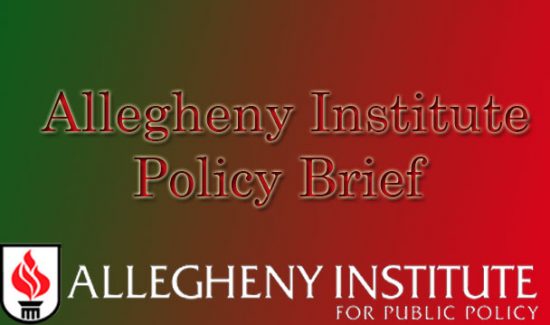Pittsburgh International Still Struggling
(February 18, 2014)–Pittsburgh International Airport’s (PIT) struggles to grow passenger counts and flights have been well chronicled in past Policy Briefs. One obvious culprit has been the high fees charged to airlines doing business at PIT. The high fees are driven by the need for the airport to generate revenue to pay off debt incurred building the facility more than twenty years ago. However, thanks in large part to money coming from gaming revenue and from a recent lease allowing drilling for natural gas on airport property, PIT has been able to reduce some of these fees.
Everything equal, the reduction in fees should encourage more flight activity. But, it might be an uphill battle. Note that passenger counts for 2013 (through November) were below 2012 levels which were below 2011 levels. Whether the airlines and travelers respond positively to the lower fees, remains to be seen. And that leads to the inevitable question. What can be done to make passenger counts take off at PIT?
The terminal at PIT, built at the request and to the specifications of USAirways, has become a financial albatross for the Airport Authority. According to the most recent comprehensive annual financial report (2012), PIT still owes $375 million in revenue bonds associated with the construction. Coupled with more than $20 million in other debt, and PIT’s annual debt service is projected to be just over $68 million in 2014. It dips to around $67 million in 2015 and 2016 and to $63 million in 2017 before falling to just over $23 million per year for 2018 through 2022. With operating revenues in 2012 exceeding $135.8 million, debt service (interest and principal) consumed about half of PIT’s operating revenues.
The largest component of operating revenues at PIT is terminal fees (42 percent), followed by parking revenues (21 percent) and landing fees (13 percent). The terminal fee rate for signatory airlines (those who have an agreement with PIT) at the facility has been well above that charged by similar airports. In 2012, the rate was $129.06 per square foot. By comparison, Indianapolis ($92.80), Denver ($70.219), Kansas City ($30.09) and Cincinnati ($28) were much lower. After PIT raised the fee nearly ten percent in 2013, it was reduced to $138.82 for 2014, but remains above the 2012 figure.
Meanwhile, the signatory landing rate was $3.4148 per 1,000 pounds in 2012 and was much more competitive with other airports. In fact, it was lower than Denver ($3.914) and Cincinnati ($3.998). The landing fee was also raised for 2013 (slightly) before dropping nearly 20 percent to $2.81 for 2014.
Given the large debt load, it might seem to be counterproductive to lower the fees that comprise the bulk of the operating revenues. But since the airport is no longer a major hub, and appears unlikely to become one again, it has to rely on enticing carriers to offer point-to-point service for passengers using PIT for the origination and destination (O&D) of their travel. This effort to reduce carrier costs received a boost when the airport was the recipient of money from the state’s gaming law, which from 2010 through 2012 amounted to $39.4 million, to be applied specifically to debt service at PIT. They were allotted $150 million under the law, but the first $42 million was intercepted by the County Executive at the time and used for the County’s budget.
In another fortuitous circumstance, the natural gas boom in the Marcellus Shale formation had drilling companies bidding on the rights to drill on airport property. The winning bidder paid an upfront bonus, reportedly up to $40 million, and will pay royalties when extraction commences. This allowed PIT to lower airline fees midway through 2013 then again at the start of 2014.
Whether or not these cuts will be enough to attract airlines to offer more service to more destinations remains to be seen. In another attempt to lure airlines, the Airport Authority has recently unveiled plans to offer a subsidy to airlines that are willing to offer nonstop flights to select locations, such as San Diego or Seattle. The subsidy will take the form of either marketing assistance or a waiver of landing fees. This is a direct attempt to cater to the O&D market as the list of cities was chosen based on a survey of businesses.
And of course that is the point; PIT is no longer a hub that can rely on a large number of flights carrying passengers who are connecting with other flights, so it must work to increase the number of O&D travelers. While they can work on promotions such as the one mentioned above, and make efforts to reduce airline costs, they will be relying heavily on the regional economy and to some degree on the strength of the national economy.
Unfortunately, the local labor market has not been overly supportive. While private employment growth in the seven county Pittsburgh metropolitan statistical area (MSA) has outpaced that of the state, it still has not been robust. In 2013 only two months, September and October, posted growth rates in private employment that were two percent over the same month a year earlier. In 2012, this only happened in the first four months. Thus, the remaining sixteen months over the last two years had growth rates less than two percent over their year earlier totals. The good news is that job gains in the region have been stronger than the state growth.
That being said, some of the sectors that have lead the job gains (such as education and health, and leisure and hospitality) are not sectors that are big drivers of employee air travel. The Marcellus Shale boom has caused jobs in the mining and logging sector to more than double over the last few years, but total employment in that sector accounts for only about one percent of the total private jobs in the MSA.
The major and somewhat surprising bright spot in job creation has been the professional and business sector, specifically the professional and technical subsector. The professional and technical subsector has grown at a year over year rate ranging from 5 to 8 percent during 2013 and accounts for a significant fraction of all net new private jobs. As we wrote previously, detailed data as to which areas within this subsector are experiencing the most growth are not available at the MSA level, giving some cause for concern about the accuracy of the numbers being reported. But the positive news for PIT is that these may be employees with a need for air travel or at least with enough income to stimulate demand for travel.
Moving forward, PIT needs to do all it can to right its financial ship, such as using the new found sources of revenues to lower debt obligation and lower carrier fees further thereby becoming more competitive with other airports in attracting airlines and flights. It also ought to be involved in trying to promote more business friendly policies to stimulate regional economic growth and demand for air travel, be it for business or pleasure.
Frank Gamrat, Ph.D., Sr. Research Associate
If you wish to support our efforts please consider becoming a donor to the Allegheny Institute.The Allegheny Institute is a 501(c)(3) non-profit organization and all contributions are tax deductible.Please mail your contribution to:
The Allegheny Institute
305 Mt. Lebanon Boulevard
Suite 208
Pittsburgh, PA15234
For more on this topic click here
Link to Allegheny Institute Website
Forward this Brief to a friend




